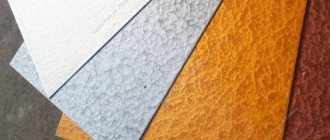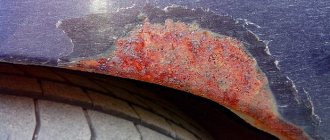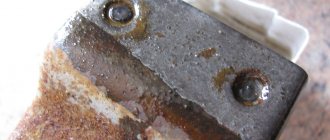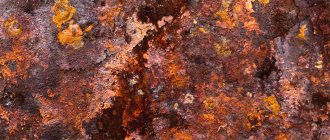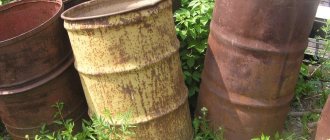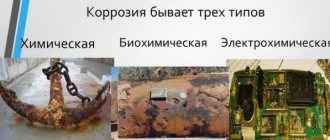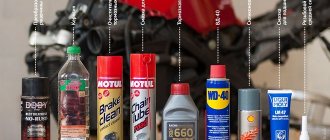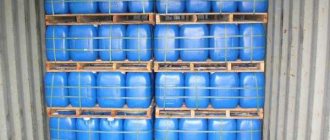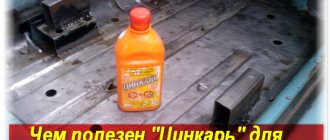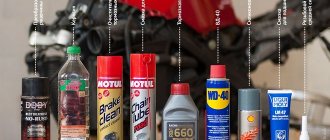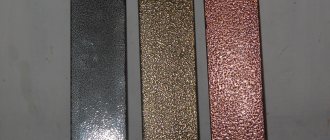How to create a rust effect on metal and other surfaces?
Today, the rust effect is one of the most popular finishing options for metal and other surfaces.
There are two simple ways to give a coating a hint of rust: imitation rusting and natural rusting of metal using special chemical reagents.
In this article we will look at the most effective ways to rust metal at home and during industrial processing.
Natural rust
As you know, any metal surface loses its original appearance over time, losing not only technical, but also external properties.
Metals are characterized by natural rusting, which occurs due to the negative impact of environmental factors.
If it is necessary to create natural rust on metal, you can simply speed up this process by using chemical reagents - their action is aimed at forming a layer of metal corrosion.
Before carrying out a chemical reaction, you need to make sure that the metal used is susceptible to corrosion. Rust appears only on metal surfaces that contain iron. Some metals are more resistant to corrosion - often these are chrome compounds or so-called stainless steel. Cast iron and wrought iron are also suitable for chemical rusting.
First method: cupric acid solution
One of the easiest ways to create natural rust is to use a copper-acid solution. Its manufacture does not require the presence of any specific reagents; the most important thing is to strictly follow the technical conditions and procedure for performing the operation:
- About sixty milliliters of hydrochloric acid is poured into a prepared (pre-cleaned) container. A prerequisite is the use of protective glasses and gloves made of thick rubber.
- Next, a small amount of copper (copper wire or coins) must be dissolved in hydrochloric acid, after which the solution must infuse for seven days to accelerate corrosion processes on the metal.
- Residues of copper should be removed from the resulting composition. Dilute the prepared copper-acid solution with water in the proportion: one part acid to fifty parts water.
- Next, the metal is cleaned (removal of the paint layer, plaster and other finishing materials), after which the surface is thoroughly washed with a soap solution.
- The copper-acid solution must be applied using a special spray gun or a regular construction brush. At the same time, follow all safety rules and pay special attention to room ventilation.
Approximately two hours after application, a rusty effect will appear on the surface. There is no need to wash off the mixture, since the composition will evaporate on its own after some time. If there is not enough rust formed, the procedure can be repeated in order to achieve the desired result.
Method Two: Vinegar and Bleach
There is another way to make rust easily and quickly at home - using vinegar and bleach.
This method is suitable only for surfaces that were not finished with a primer or various sealing compounds.
The combination of vinegar and bleach gives the maximum effect of natural rusting if the metal products contain tin or iron.
Let's look at the instructions for coating a metal product with rust:
- At the first stage, carefully inspect the object for the presence of extraneous traces of old coatings, clean if necessary.
- Next, mix one part vinegar and two parts bleach in a prepared container. The volume of the mixture may vary depending on the size of the item you are going to rust.
- Place the metal product in the solution for thirty minutes - during this period of time, a cracked layer of rust will form on the surface of the object.
- Wipe up any remaining mixture with a regular paper towel, and discard any remaining vinegar and bleach.
- Once the product is completely dry, remove as much rust as necessary (depending on the desired result). Some people prefer a thick layer of rusty coating, while others prefer superficial corrosion on metal and other surfaces.
To fix the resulting effect on the object, use a special primer in an aerosol or a matte sealant in the form of a spray.
On video: three simple ways to create noble rust.
Imitation of natural rust on metal
Is it possible to rust metal without distorting the natural structure of the material? In such cases, imitation of rusting is used using a special coloring composition or rust film. Please note that you can give the rust effect to both metal and other materials, such as wood.
Paints and pigments
To make a product rusty, acrylic-based rust paint is most often used. Now such a mixture can be purchased at any hardware store.
How is rust paint created? Rusty shades are created through the interaction of brown, yellow and red pigments.
Blue pigment can also be added to give the coating greater depth and color saturation.
There is also a natural pigment, which, when used alone, gives the appearance that the surface has rusted over time, and not as a result of decorative finishing work - this is iron lead or ocher (a mixture of iron oxide hydrate and clay).
Natural ocher is not used for painting metal objects. It is only a fundamental component and is added to paints and varnishes (paints, primers, enamels).
Regardless of what kind of paint you are going to use - purchased or prepared yourself based on red lead, the mixture should be applied to a cleaned and degreased surface. To create a realistic rust texture, paint can be applied using a porous sponge or dry brush (to simulate streaks).
Simulating film
In building and finishing materials stores you can find self-adhesive film with a picture of rust. This is also a good option that will allow you to quickly and without any problems get the desired effect. However, it is recommended to glue such a film on a perfectly flat surface, otherwise air bubbles may appear, or in some places the film will simply peel off.
Most often, rust imitation film is used by car owners who want to tune their car.
How to use the film:
- The surface that needs to be decorated must be degreased (with alcohol or a special degreaser).
- Attach the film to the base and mark the areas or contours that need to be cut out.
- Detach the film from the backing and begin gluing the piece in the middle, gradually leveling it towards the edges.
Pigments and household products (25 photos)
Why do some things rust?
Have you ever seen a very old car? How about an old metal wrench or tool set? Maybe you've seen an old bicycle lying around. If any of these items have been neglected and left unattended for several years, they are likely in poor condition. In fact, they probably turned a reddish-brown color. They may even peel off in many places.
What is this reddish-brown material? These are spots where the metal has been corroded and are called rust. When metal objects rust, they are at risk. If they are not taken care of properly soon, they will be of no use to anyone.
But what is rust? Rust is a very common compound. Its scientific name is iron oxide (Fe2O3). Rust forms when iron and oxygen react in the presence of water or moisture in the air.
But did you know that rust is not always reddish-brown in color? Would you believe that sometimes it's green? This is true! When iron reacts with chloride in an underwater environment, green rust appears. This can sometimes be seen on steel used in underwater poles.
Rust occurs when iron or its alloys, such as steel, corrode. In the presence of oxygen and water, the surface of a piece of iron will first corrode. Over time, any piece of iron will completely turn to rust and disintegrate.
The rusting process is a combustion reaction similar to fire. When exposed to oxygen, iron reacts with oxygen to form rust. However, unlike fire, the reaction is much slower and does not cause flames.
There are certain factors that can speed up the rusting process. For example, water speeds up the reaction. Other substances, such as salt, can also speed up the rusting process.
Iron can be coated to prevent rust. This prevents it from reacting with oxygen and water. One such process is called galvanization. This usually involves coating an iron object with a layer of zinc. Zinc prevents iron from reacting with oxygen and water to form rust.
Another rust prevention method is much simpler and more common. What is it? Paint it! Like this. A simple coat of paint can prevent iron from reacting with oxygen and water in the environment.
Do you have rusty items at home? How can you protect them from corrosion? Act quickly! They may be beyond repair before you know it.
Standards: CCRA.L.3, CCRA.L.6, CCRA.R.1, CCRA.R.2, CCRA.R.4, CCRA.R.10, CCRA.SL.1, NGSS.PS1.B,
.
How to speed up the rusting of metal - Metalworker's Guide
Due to the fact that many objects in the apartment are metal or have metal parts, almost every person is ever faced with the need to wash off rust.
Corrosion does not bode well. Guys are worried that it will appear on the car body, the right tool. Girls are worried about spoons, pans and other kitchen utensils.
If you find that something is covered with a brown-orange coating, do not rush to throw it away. By understanding how to remove rust from metal, you can save money on purchasing new items. You can try to stop the corrosive effects using available means.
Causes of corrosion
If a metal that contains certain additives or impurities (for example, carbon) comes into contact with liquid, air or other powerful oxidizing agent/acid, it becomes corrosive. If salt (sea water) is present in the liquid, metal corrosion increases. This is due to electrochemical reactions. Pure iron is quite resistant to the influence of water and air.
As with other metals, the passivation layer provides protection against oxidation. This layer turns into rust due to the combined effects of 2 reagents.
Other corrosive factors include sulfur dioxide and carbon dioxide. Under such aggressive conditions, different types of iron hydroxide appear.
As hydroxide forms and moves away from the surface, the next layer of metal is subject to corrosion.
Metal corrosion will end only when the iron is destroyed or the aggressive factors are eliminated.
Methods for removing rust at home
How to clean rust from metal? This question has been asked by many people for a long time.
There are various folk methods that make it possible to remove rust from metal at home.
The effectiveness of such methods does not allow them to cease to be popular. It is possible to remove rust from both metal and fabric.
Table acetic acid
Vinegar is an excellent way to combat corrosion. It dissolves brown plaque flakes. If you need to remove rust from a small item (coin, knife, pliers, key, jewelry), keep it in table acetic acid for a couple of hours.
After the crusty layer has softened, remove it with a crumpled piece of aluminum foil. It has enough rigidity to remove rust from metal. At the same time, the foil does not deform the coating of the object, which cannot be said about a metal brush.
If rust appears on a large object (hacksaw, shovel, ladder, fittings), you need to thoroughly wet a cloth with acetic acid and wipe the rusted parts with it. After some time, the plaque will soften and it will be possible to remove rust from the metal using a special brush.
Lime and salt
Acid with salt is deservedly considered one of the best rust removers. This is the second most common method of eliminating rye and stopping the corrosive effects. Cut the lime in half and squeeze as much juice as you can onto the rusty parts. Sprinkle the soaked areas with salt.
Don't throw away the lime peel. It will serve as a “sponge” that removes softened rust. After two hours of etching, try to scrub off the corrosion. If it does not give in, wait a while. You can use lemon juice instead of lime, but lime will help dissolve the problem much more effectively.
Soda
Make a baking soda mixture by mixing baking soda with water. Clear proportions are not defined. The mixture should be similar to rich sour cream or toothpaste. The finished mixture is placed in a thin layer on the rust and waited for two to three hours.
Do not think that after this period the corrosion will disappear and the metal will shine. To remove rust from metal, use a toothbrush and a piece of aluminum foil. After treating the rust, corrosion will be eliminated.
Potatoes and laundry soap
Using a similar method, it is possible to remove rust from metal at home, both small and large things. The potato tuber must be cut in half, and the cut should be wiped with laundry soap.
After this, place the potato on the rusted part. When in contact with soap and potatoes, corrosion starts a chemical reaction. After a couple of hours, you can try to wash off the brown deposits with a stream of hot water.
Lemon acid
Make a solution of citric acid (three packets per liter of water). Boil the finished mixture and turn off the gas stove.
Place rusty things (screwdrivers, pliers, screws, nails, etc.) in boiling water. You will immediately see the liquid in the container bubble.
Treating rust by soaking requires at least eight hours. Softened rust is removed with a brush or sponge.
Oxalic acid
It is necessary to remove rust from metal before painting in a ventilated area. Be careful! Use rubber gloves, special glasses, and a robe. If acid gets on your skin or eyes, you will get very severe burns.
How to rust metal at home
Humidity, yes. What else?
and an oxidizing agent, of course.
If a piece of iron needs to “rust,” then you can attach copper crap to it.
How to make rust on metal and wood surfaces
Paint guru➣Special materials➣Corrosion➣
In recent years, rusty color has become increasingly popular. You can achieve this color in one of two ways: imitate rusting or rust the metal naturally. How to make rust in various ways will be discussed below.
Natural rust
This article does not take into account the natural rusting of metal, which gradually occurs to it under the influence of the environment. Natural rust can be accelerated by a chemical reaction that causes corrosion of the metal.
First of all, you need to make sure that the metal you want to rust is susceptible to corrosion. Metals containing iron are susceptible to rust. However, many materials are resistant to rust, such as stainless steel or chrome alloys. Wrought iron and cast iron are susceptible to corrosion.
Copper acid solution
Instructions:
- Pour 60 milliliters of hydrochloric acid (hydrochloric acid) into the container. During the process, be sure to use protective gloves and goggles.
- Dissolve some copper (copper wire, coins, etc.) in acid. The container should not be closed too tightly, as the reaction will produce gases inside. Thus, after about 7 days we obtain a solution that provokes corrosion processes.
- Remove copper residues from the acid. We dilute the copper-acid solution with water in the following proportion: add 50 parts of water to 1 part acid.
- We clean the metal that will rust from paint. Wash the surface with soap and water.
- Apply a thin layer of acid to the metal. This can be done using a spray bottle or brush. Let the material dry in the fresh air. At the same time, as before, do not forget about protective measures (gloves and goggles), as well as good ventilation of the room.
- After about an hour, visible rust will appear on the metal surface. There is no need to rinse off the solution, as it will gradually evaporate naturally. If the rust that has formed seems insufficient, you can treat the surface again.
Methods for restoring rusty iron
As a result of exposure of iron to air and other substances, it oxidizes. There is an electrical, chemical, electrochemical reaction, after which rust is formed. Various methods are used to clean rusty iron and further protect it.
Rust control methods
Iron corrosion damages industrial equipment and causes many losses. To prevent this from happening, you need to properly treat the surface with high-quality paints and varnishes. The abrasion-resistant cleaning method is considered the most effective.
There are 3 ways to prevent rust stains:
- Structural.
- Passive.
- Active.
To prevent corrosion, structural stainless steel is used. When equipment is designed, all parts are protected from the effects of a corrosive environment with adhesives, sealants, and elastic gaskets.
With the active method, the parts are exposed to an electric field using equipment that supplies direct current. To increase the electrode potential of iron products, a suitable voltage is selected.
Sometimes sacrificial anodes taken from more active elements are used; this method is called passive. Metal parts are protected by a special anti-corrosion coating.
Oxygen corrosion occurs on tin-plated parts. Paint, enamel or polymers are used to protect exposed metal from water and air. Often steel is coated with tin, nickel, zinc, and chromium. The base material remains protected even after partial destruction of the protective layer. Zinc has a more negative potential, so it rusts first.
Tin cans are made from tin. When the tin layer is deformed, the iron quickly rusts, since the potential for such protection is more positive. The metal is protected from corrosion by chrome plating.
Zinc and magnesium have a more negative potential, making them excellent for coating metals. This method of protection is called cathodic; it prevents the development of a corrosive coating on many products. Zinc plates are installed on marine vessels, underground communications, and other equipment to protect the hull.
An oxide film is formed on the zinc and magnesium layers, which inhibits the destructive process. If you add a little chromium to the steel, the products will be protected.
Thermal spraying is used to combat corrosion and helps restore various equipment. Using special equipment, another metal is applied to the surface, resulting in corrosion occurring slowly.
Metals that are to be used in an aggressive environment are treated with thermal diffusion zinc coating. This method provides the greatest protection; the coating does not peel off or chip after impact or deformation.
The metals are treated with cadmium, which protects well even in sea water. Cadmium is highly toxic and is therefore not used often.
Treatment with chemicals
Everyone understands why iron parts rust. We list the categories of chemical reagents that help get rid of corrosive formations:
- Rust converters.
- Acids.
Acids are solvents consisting of orthophosphates that help restore rusting products. The technology for using acid is simple. The metal must be cleaned of dirt and dust and treated with acid using a silicone brush.
The chemical interacts with the damaged surface for 30 minutes, after cleaning the product is wiped dry. The acid should not affect the skin, eyes, or mucous membranes, therefore, during such treatment it is necessary to wear special clothing. The orthophosphate mixture has the following advantages:
- Gentle effect on iron.
- Removing rusty deposits.
- Preventing new corrosion.
The entire surface of the metal product is treated with the converter. Active substances create a protective anti-corrosion layer that prevents its development.
Popular converters:
- Berner - for protecting bolts and nuts that are difficult to unscrew.
- BCH-1 neutralizes rust on damaged areas and can be wiped off with a regular rag.
- "Zinkor" cleans from corrosion and prevents further destruction.
- B-52 is a gel converter that helps get rid of different types of rust stains.
- SF-1 - it is used to process cast iron, zinc, aluminum, it prolongs the service life of iron objects for a long time.
Most anti-corrosion compounds are made from toxic components, so you need to protect yourself with respirators, gloves, and goggles.
Application of anti-corrosion compounds
Rocket Chemical company supplies high-quality anti-corrosion products to the domestic market. We list the most popular products:
- Potent inhibitor. After treatment, iron objects do not rust for a year in an aggressive environment.
- Lithium grease – for protection and prevention. It is used to process door hinges, iron cables, chains, and various mechanisms. The protective layer is not washed off by rain.
- Silicone sealant covers metal products with plastic or rubber elements.
- Anti-corrosion spray - for treating hard-to-reach areas. The sprayer allows for deep penetration into various mechanisms. Prevents the recurrence of rusty plaque.
- The spray for removing rust stains is made from non-toxic elements. It is used to clean building materials, household appliances, knives, etc. – valid for 5 hours, after which the item is wiped or washed.
Iron is most resistant to corrosion in conditions of minimal humidity.
Folk remedies
You can clean metal using improvised materials:
- Lemon and vinegar help get rid of light plaque. The ingredients are mixed in equal proportions. After processing the iron, you need to wait 2 hours. Then wash off and wipe dry.
- Potatoes have a destructive effect on rusty plaque. Potatoes are cut, salted well, and applied to the spots. Oxidation products are washed off from products.
- Baking soda is highly effective. The powder is diluted with water until a thick mixture is formed. You need to wait 30 minutes, then wipe the surface dry and remove any remaining dirt.
It is not easy to treat rust so that the iron does not deteriorate. You will have to pay a lot of money for quality products. To achieve an ideal result after cleaning, you will have to organize special conditions. Only large industrial enterprises can afford this.
Useful materials
Vinegar helps fight corrosion and removes brown deposits. It can be used to clean a coin, a knife blade, a key, or jewelry.
Lime and salt are the most effective combination. The product is processed with juice, salted, and peeled with lime peel.
Oxalic acid is an aggressive agent; the vapors released as a result of a chemical reaction affect the mucous membrane of the respiratory tract, so protection is necessary. The room is ventilated. The acid is dissolved in water, an object is placed there, and the plaque is removed with an old toothbrush.
How to speed up the rusting of metal?
In the first part of our article, we talked about the types of rust and the reasons for its appearance. Now it’s worth considering options for “fighting” it.
What accelerates the destruction of metal? The environment, polluted by factors of technological progress, affects the metal, destroying it. It is impossible to completely eliminate this influence, but ways can be found to slow down the rusting process.
There are three main groups of methods that can slow down the rate of metal destruction:
- Structural
- Active
- Passive
Structural
Initially, what you should pay attention to is internal protection: the chemical composition and structure of the metal. The addition of impurities such as nickel and titanium during steel production increases its corrosion resistance. This process is called alloying. When chromium is added, an oxide film is formed on the surface of the metal, transferring the metal to a passive state.
Another type of alloy steel - corten, at first glance appears to be bronze, although in reality it is simply rusty - after the formation of a layer of rust, its oxide film is no longer washed away by water and the destruction process stops. When copper is added to a metal alloy, corrosion resistance increases several times.
Active
A method in which the potential of the electric field on the surface of a metal is changed. This type of protection is also called electrochemical protection. This method can be divided into two large groups: cathodic protection and anodic.
With cathodic protection, a change in potential is achieved by connecting the protected object to a current source. In this case, the product will serve as a cathode, and auxiliary inert electrodes will serve as the anode. They are also called “sacrificial” anodes. They consist of a more active material that will break down, thereby protecting our product.
Anodic protection is based on the same principle as cathodic protection. The difference is that the electrical potential of the structure increases (becomes more positive) and the metal becomes passive. As a result, the corrosion rate is significantly reduced.
The electrochemical method is used in cases where it is not possible to renew the protective coating (metal, paint). For example, in underground pipelines or on the bottoms of sea vessels, on drilling platforms and large pile foundations.
Passive
The method includes such activities as processing with fat, oil, various metals and other materials. For convenience, we will divide them into metal and non-metallic coatings.
Protection by non-metallic coatings
Paints and polymers form a protective layer on the metal surface, thereby eliminating the possibility of contact with water and aggressive environments. The convenience of paintwork materials is that the painting process is quite simple and economical. If the coating is damaged, it can always be “touched up” right on the spot.
Polymers - epoxy resins, polyvinyl chloride, polyethylene - can act as protective coatings.
We will look at the types of paints and methods of applying them in more detail in the next article.
Protecting iron with metal coatings
Among metal coatings, two types can be distinguished: protective (zinc, aluminum and cadmium) and corrosion-resistant (plating with silver, copper, nickel, chromium and lead). Thus, the first group of metals has greater electronegativity with respect to iron, the second - electropositivity.
Tin coating and galvanizing are very popular, since the application technology is quite simple. A more effective solution would be an aluminum coating, which is more resistant to aggressive substances.
An important detail when using passive methods is that corrosion protection depends 80% on proper preparation of the metal, and 20% on the quality of the materials used and the method of their application.
An easy and quick means of preliminary surface preparation is mechanical abrasive treatment. A more expensive method is laser cleaning, which uses pulses to remove dirt, oxides and other contaminants. The most common cleaning option is chemical.
Additional protection options
Finally, one more aspect is worth mentioning. All this time we have been considering the possibilities of protecting metal from the environment, but did not take into account the fact that the aggressiveness of the environment can also be reduced.
You can protect yourself from electrochemical destruction of metal by using non-metallic inhibitors. It is necessary to minimize the number of elements causing an electrochemical reaction.
In practice, such actions will include reducing soil acidity and changing the composition of aqueous media in direct contact with the metal. For example, in the electric power industry it is practiced to purify water from chlorides.
To reduce corrosion of some metal products (copper, brass, zinc, etc.), oxygen and carbon dioxide are removed from liquids.
How to create a rust effect on metal and other surfaces?
Today, the rust effect is one of the most popular finishing options for metal and other surfaces.
There are two simple ways to give a coating a hint of rust: imitation rusting and natural rusting of metal using special chemical reagents.
In this article we will look at the most effective ways to rust metal at home and during industrial processing.
Mill scale removal
Cor-Ten steel plates with a thickness of more than 2 mm are hot rolled. As a result, mill scale forms on the surface of the sheets. This must be removed to allow the correct aging process to continue and a proper layer of rust to be achieved in the final treatment. Typically, the process of removing mill scale is carried out using blasting. Blasting
implies sandblasting, shot blasting or glass blasting abrasive processing. As a result, mill scale is completely removed from the surface of Corten steel, and the pores of the metal itself are exposed, which makes it ready for subsequent “aging.” The quality of preparation of corten steel in this case depends on the type of abrasive particles, the power of the supplied jet and the distance of the jet from the surface.
Unfortunately, sandblasting, shot blasting or glass blasting is quite expensive and requires specific equipment.
Our company offers an alternative to abrasive processing - chemical removal of mill scale, the so-called pickling.
Suitable products for this treatment are
a liquid product
for use by dipping in pickling baths and
a gel product
for use either by spraying with acid-resistant sprayers or by applying with acid-resistant brushes.
These products are capable of completely removing scale from corten steel sheets in 20-40 minutes and preparing it for further processing. However, it is worth remembering that before the etching process, it is necessary to remove all contaminants from the surface of the steel, such as oils, greases, coolants, and so on. For this purpose, we offer a degreasing agent.
How to rust metal: creating natural rust and imitation
The appearance of rust on metal surfaces and parts is a very common phenomenon that is often encountered not only by motorists. Corrosion is a chemical reaction that causes damage to metal.
Cleaning rust from iron at home is one of the frequently asked questions that does not have a definite answer.
In this material we will look at all possible ways to combat corrosion, and what tools, preparations and improvised means will be needed for this.
First method: cupric acid solution
One of the easiest ways to create natural rust is to use a copper-acid solution. Its manufacture does not require the presence of any specific reagents; the most important thing is to strictly follow the technical conditions and procedure for performing the operation:
- About sixty milliliters of hydrochloric acid is poured into a prepared (pre-cleaned) container. A prerequisite is the use of protective glasses and gloves made of thick rubber.
- Next, a small amount of copper (copper wire or coins) must be dissolved in hydrochloric acid, after which the solution must infuse for seven days to accelerate corrosion processes on the metal.
- Residues of copper should be removed from the resulting composition. Dilute the prepared copper-acid solution with water in the proportion: one part acid to fifty parts water.
- Next, the metal is cleaned (removal of the paint layer, plaster and other finishing materials), after which the surface is thoroughly washed with a soap solution.
- The copper-acid solution must be applied using a special spray gun or a regular construction brush. At the same time, follow all safety rules and pay special attention to room ventilation.
Mechanical cleaning
The mechanical method of removing corrosion has proven to be the most effective. Metal rust removal is done manually or using power tools. There are several ways to remove rust mechanically.
1. Cleaning the surface with wire brushes. It is used for removing small pockets of corrosion and cleaning welds and for primary treatment of surfaces covered with a thick layer of rust. The quality of cleaning is not very good; the brushes do not remove scale at all. In addition, the processing process generates a lot of dust.
2. Abrasive processing of metal using grinding discs. Used for small areas of corrosion. If high quality discs are used to perform the operation, the result is good. Processing metal with an abrasive tool has two disadvantages:
- consumption of quality materials;
- requirements for certain skills to perform work.
Painting process
How to paint a metal fence
When painting metal products, you need to take into account that the temperature of such a surface, heated by the sun, can be much higher than the ambient temperature.
Painting heated products can lead to unwanted defects.
In summer, it is recommended to carry out such work in the morning.
On the other hand, painting wet, damp or condensation-covered surfaces is unacceptable.
Fog also creates excess humidity. The weather during the painting process of metal products located outdoors should be dry.
To apply paint you can use the following tools:
- Using paint brushes (care must be taken to ensure that streaks, streaks and drops do not form; a good method for products with complex shapes).
- Using rollers (preferably 30 cm in length; moving the roller from top to bottom, you need to overlap the strips).
- Spray paint sprayer (the most economical option).
One-time painting rarely gives the expected result. Usually it is necessary to make 2-3 layers, sometimes four or more. Allow at least 3 hours for the paint to cure before applying the next coat.
Dye
The rusty shade is formed by mixing red, yellow and brown pigments. You can also add a little blue - this will add brightness and depth to the coating.
There is a natural pigment that, without any mixing of different colors, makes it possible to obtain a rusty tint. This pigment is called ocher (another name is red lead), which is a mixture of clay and iron oxide hydrate.
Natural ocher is not an independent type of paint. This is just a component that is added in varying quantities to paints and varnishes (paints, enamels) and primers. In addition to this component, paints also contain other substances.
The pigment has the following characteristics:
- hiding power - from 60 to 80 grams per square meter;
- oil absorption - from 25 to 35 grams per 100 grams of substance;
- The pH of the water extract is from 7 to 8.
Ocher is characterized by resistance to aggressive chemicals (organic solvents, acids, alkalis), as well as resistance to light and humidity.
How to prevent a knife from rusting?
#1
Any housewife knows that the only knives in the kitchen that are always clean and shiny are those that are constantly used. But remember, there are practically no good knives that do not rust. Stainless steel kitchen knives are quite soft, easy to bend and dull quickly.
Causes of rust: knives are made from various grades of steel, which have all sorts of additives and impurities of other metals. This is done to create products for various applications and various properties, such as resistance to dullness, flexibility, rigidity, weight and others.
As a result of the oxidation of metals with oxygen, water, and salt, rust appears on it, which leads to a change in the properties of the knife and loss of appearance.
Applying protective varnish or wax
The application of a protective varnish or wax will add the finishing touch to our corten steel surface and, at the same time, provide long-lasting protection to the oxide layer formed earlier. It can also be given a variety of finishes: a semi-gloss or matte finish for interior applications and a gloss, semi-gloss or matte finish for exterior applications (exterior). Varnishes will not affect the color of Corten steel. For interior products, we recommend applying varnish in 2 layers. If cor-ten steel will be used in landscape design or on building facades, then it is best to apply 3 or more layers depending on environmental conditions.
Warning
The varnish must be applied using a spray gun. Do not use brushes or rollers under any circumstances; they can ruin the aged surface of the Corten steel. Do not apply a protective coating of varnish without making sure that the steel is completely dry from the previous treatment, otherwise the varnish will not adhere to the surface and will lose its protective properties.
How to quickly rust metal
Due to the fact that many objects in the apartment are metal or have metal parts, almost every person is ever faced with the need to wash off rust. Corrosion does not bode well. Guys are worried that it will appear on the car body, the right tool. Girls are worried about spoons, pans and other kitchen utensils.
If you find that something is covered with a brown-orange coating, do not rush to throw it away. By understanding how to remove rust from metal, you can save money on purchasing new items. You can try to stop the corrosive effects using available means.
Work examples
Application of metallized zinc coating on the end sheet of metal structures of the superstructures of the Adler - Mountain-climatic resort Alpika service road bridge. Work area 2335m2.
Application of metallized zinc coating on the end sheet of metal structures of the superstructures of the Adler - Mountain-climatic resort Alpika service road bridge. Work area 2335m2.
Application of metallized zinc coating on the structures of POARE trusses for a waterworks in the Ryazan region.
Application of metallized zinc coating on the structures of POARE trusses for a waterworks in the Ryazan region.
Application of metallized zinc coating followed by painting on lighting installations for the stadium in Khimki
Application of metallized zinc coating on the structures of POARE trusses for a waterworks in the Ryazan region.
Aluminum metallization of a metal chimney
Chimney of CHPP-26
Combined metallization coating of a chimney
Application of zinc coating on the metal structures of the lifting mechanism for the Optima-Stroy company. Moscow city.
Application of metallized zinc coating on a support for the cable car of an Olympic facility. Sochi. Outer side.
Application of metallized zinc coating on a support for the cable car of an Olympic facility. Sochi. Inner side.
Anti-corrosion metallization coating of metal structures, trusses, I-beams.
Applying zinc plating to a cell tower.
Applying zinc plating to a cell tower.
Applying markings to metal structures after processing
Applying markings to metal structures after processing
Additional Tips
The accumulated experience of users and recommendations from specialists can help deal with rust on metal products more quickly and efficiently.
When using a homemade composition, it is worth remembering:
Depending on the degree of corrosion, it is advisable to use more powerful tools to remove rusty deposits: an angle grinder, sandblasting devices.- When using different methods of mechanical cleaning of rust, coarse-grained samples are first used, gradually moving to fine, fine-grained sandpaper.
- Before using the modifier, it must be shaken or stirred to create a uniform distribution of the active ingredients by volume.
- The container in which the ingredients are mixed must be glass, enamel, or ceramic. It is not recommended to use aluminum cookware.
- For convenient application of the product, you can use not only cloth napkins or rags, but also a spray bottle. It helps in cases where contact with the problem area is impossible.
- Each applied layer (anti-rust, primer) must be thoroughly dried. Otherwise, it is washed off by the subsequent layer and becomes ineffective.
Chemicals
You can remove the unattractive red coating from the surface with a wire brush or sandpaper. Sandblasting can also come to the rescue, but not every home has it. Small parts are difficult to process mechanically, and it is difficult to wipe off old marks with sandpaper, so it is worth choosing a simpler and more effective method to solve the problem.
Simple things are complicated. "sleeping steel" how to lubricate rusted bolts or not with wd-40 alone...
Dedicated to all those who are desperate and have lost hope... unscrew the rusty nut!
Spring has definitely arrived on the streets of our cities. It got warmer and people happily began to give preference to their real iron friends, at least for a while forgetting about tablets and smartphones.
Cyclists, motorcyclists and many other lovers of seasonal means of transportation took out their belongings and suddenly discovered that something was rusty, something could not be unscrewed, etc. and so on. I confess that I am one of these who discovered
Pros and cons of a homemade product
The anti-rust product, made by yourself, has a number of advantages. However, it cannot completely replace professional converters. Due to the existing disadvantages, many users prefer ready-made store-bought chemicals. For an objective assessment, it is necessary to consider both the pros and cons.
Homemade composition is valued for the fact that it:
It is not toxic to humans, as it consists of harmless substances.- Does not require very complex and time-consuming manufacturing technology.
- Has simple and clear instructions for use.
- Helps achieve rust removal and coating protection.
- It is much cheaper than branded analogues.
The disadvantages of a homemade converter make its use limited and reduce its popularity among motorists, housewives and production workers.
The weak points of the homemade corrosion modifier are:
- The need to find a convenient container and method of application.
- Can only be used with a thin layer of rust.
- Lower efficiency compared to special means.
- The need for mandatory coating of the product with paint or varnish.
How to clean the surface?
To achieve a good result, rust removal must combine an integrated approach: mechanical and chemical action.
In addition, electrochemical effects can be used by passing an electric current through a special solution. This method is used more often in industrial settings, but can also be organized at home, despite the complexity of the organization.
You will find all the most useful and important information about rust removal methods and techniques in this section.
Acids
Let's look at what acids remove rust:
Lemon
Citric acid is a harmless product that will help deal with rust stains on metal, as well as on tiles and other surfaces.
Folk remedies
If for some reason you need to use chemicals, for example, you want to clean dishes or remove rust from a ring or other jewelry, it is better to use natural, safe methods. At home, it is not difficult to remove unattractive red plaque from dumbbells, knives, tools or auto parts if you choose the right method.
Several ways to clean rust from iron - video:
Potato
You can remove rust from knives or dishes using potatoes. Cut it in half and rub the cut part over the corroded areas. If the damage is severe, then the potatoes cut into plates are placed on the surface and left for 10–15 minutes. Then wipe the product with a damp soft cloth. You can use another method to get rid of corrosion:
- Grate the potatoes on a fine grater.
- Add lemon twisted in a meat grinder and a couple of tablespoons of table salt to the pulp.
- Apply the mixture to the rusty areas.
- Leave for a while and then rinse.
Lemon juice
The combination of lemon juice and table vinegar is a simple but effective remedy to solve the problem. It can remove even deep corrosion; just follow a few simple steps:
- Mix lemon juice and table vinegar in equal proportions.
- Apply the mixture with a brush or foam sponge to problem areas.
- Leave for a couple of hours and then rinse with clean water.
In this way, it is easy to clean rust from a faucet or pipe, as well as dishes and even various parts. If the measures taken do not help solve the problem, you should mix lemon juice with fine-grained salt. Next, apply the mixture to the problem area on the refrigerator or other surface and scrub lightly with a toothbrush. Remove any residue with a damp cloth.
Note! You can only use table vinegar. Wine or apple cider vinegar can leave dark marks that can be difficult to get rid of.
Lemon acid
You can soak stubborn rusty deposits with citric acid. Use the available tool like this:
- Dissolve 3 packets of sour powder in a liter of water.
- The prepared solution must be brought to a boil, and rusty nuts, iron nails, bolts and other products must be placed in it.
- Leave for 8 hours or overnight.
- The softened rusty layer can be easily removed with a toothbrush or sandpaper.
Prevention of corrosion
To prevent corrosion from damaging the metal, it is necessary to pay attention to preventive measures.
Surfaces without an external coating are most susceptible to corrosion . In humid conditions and with access to oxygen, such metal rusts very quickly.
The solution to the problem is timely care of metal elements, which would prevent the growth of corrosion processes. After removing the rust, it is advisable to protect the surface from moisture with a coating.
Can it be done at home?
The purpose of any rust converter is to convert iron oxides into inert compounds that form a hydrophobic film on the metal surface.
In order to achieve this goal, manufacturers select a specific chemical composition. Each company has its own secret nuances, which it tries not to disclose , so as not to provoke the creation of fakes.
In addition, the converter may include:
- tannins (convert iron oxides into neutral tannate complexes);
- zinc compounds (after reaction with phosphoric acid forms a protective layer);
- corrosion inhibitors (form an additional film, slowing down the corrosion process).
At home, it is easy to find analogues of the main active ingredients and prepare a simple but effective converter. It is prepared from a smaller number of components by conventional mixing in a container.
Step-by-step instructions for making a rust converter with your own hands
Products called “Rust Converter” help solve the problem of corrosion of metal products.
Today there is a wide range of such chemicals on sale. However, the issue of making anti-rust products on their own is of interest to many.
Having decided to use a homemade converter, you must follow the recipe and technology for its use. At the same time, it is worth remembering all the pros and cons of such a product, as well as precautions when using it.
We'll tell you how to make a rust converter with your own hands at home in this article.
LiveInternetLiveInternet
- Registration
- Entrance
—Categories
- Gallery (1582)
- Vintage (227)
- Flowers (179)
- Collage (137)
- Painting, museum (112)
- Posters and Posters (106)
- Children's (100)
- Patterns and ornaments (95)
- Birds (94)
- Cozy-vintage (91)
- Illustrations (90)
- Contemporary art (75)
- Female image (72)
- Ethnic (70)
- Still lifes (64)
- Monochrome (64)
- Feline (60)
- French vintage (60)
- Fauna (53)
- Postal (50)
- Ladies' (50)
- New Year's (44)
- Backgrounds (39)
- Landscape (34)
- Kitchen (31)
- Dogs (30)
- Butterflies (30)
- Horse (29)
- Tea (28)
- Retro (26)
- Pin-up (24)
- Cities and countries (22)
- Fruits (21)
- Provence, Mediterranean (20)
- Streets, houses, cafes. (19)
- Easter (19)
- Marine (18)
- Labels, advertising (18)
- Modern, Art Nouveau, Art Nouveau (17)
- Lettering (15)
- Angels (14)
- Poultry (14)
- Carnival (12)
- Toys, Teddy, dolls (12)
- Fabulous (12)
- Stencils (11)
- Round (11)
- Fantasy (11)
- Coffee (11)
- About love. (eleven)
- Wine (10)
- Berry (9)
- Musical (8)
- Equipment (7)
- Photography (7)
- Zodiac (7)
- Clocks, dials (6)
- Fashion (5)
- Sewing (5)
- Dance, ballet (5)
- Alphabet (5)
- Movie and pop stars (4)
- Victorian (3)
- Cowboy (3)
- Circus (3)
- Russian artists. (3)
- Gardening. (3)
- Valentine's Day (3)
- Steampunk (2)
- Insects (2)
- Windows (2)
- Templates (2)
- Folk crafts (2)
- Vegetables (1)
- Symbols of power, state (1)
- Motorcycles (1)
- Gnomes (1)
- Gambling (1)
- Cinema and theater (1)
- Antique maps, engravings (1)
- Geography, astronomy (1)
- Master class (620)
- Original decorating ideas (124)
- Imitation of various textures (91)
- LikBez (69)
- Works of masters (64)
- Modeling (46)
- Decoupage (45)
- Decorative techniques (41)
- MK on new materials (37)
- Crazy hands (36)
- Packaging (31)
- Bows, flowers (28)
- Working with plaster (26)
- Imitation lace (24)
- Aging, etching, implantation (15)
- Jute filigree, Paper art (15)
- Putty, Structural pastes (13)
- Paper (10)
- Painting (10)
- Scrap (9)
- Photoshop lessons (8)
- Color combination (7)
- Spot painting (7)
- Photography (7)
- Working with foil (5)
- Stained glass (4)
- My decoupage tutorials (4)
- Terra (3)
- False mosaic, mosaic. (2)
- Marking (2)
- Printroom (1)
- Recipes (306)
- Baking Recipes (168)
- Desserts (39)
- Main courses (34)
- Meat (22)
- Snacks (15)
- Vegetables (15)
- Salads (13)
- Fish (11)
- Sauces (10)
- Recipes for a slow cooker. (7)
- Drinks (7)
- Soups (4)
- On the grill (3)
- Health (79)
- Traditional medicine (44)
- Physical exercise (12)
- Massage (10)
- Face masks (6)
- Works of masters (74)
- Decoupage (22)
- Scrap (10)
- Modeling (6)
- Furniture. Rework. Restoration. (4)
- Painting (3)
- MY WORKS. DECOUPAGE. DECOR. (71)
- Note to the hostess (42)
- Museum (42)
- Tourism and recreation (35)
- Home Decor (29)
- Computer educational program (18)
- Aphorisms (17)
- About dacha))) (12)
- Hand-made, like a business. Adviсe. (eleven)
- Materials for decoupage (8)
- politics (7)
- Psychology) (7)
- humor (6)
- Zodiac (5)
- Historical facts (3)
- Hairstyles (3)
- Audiobook (2)
